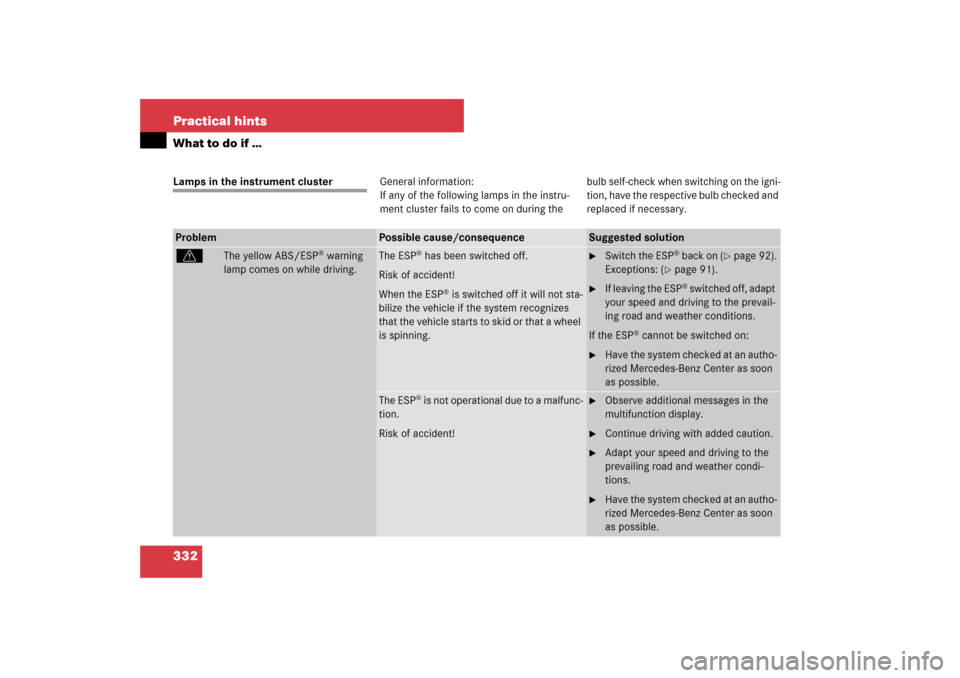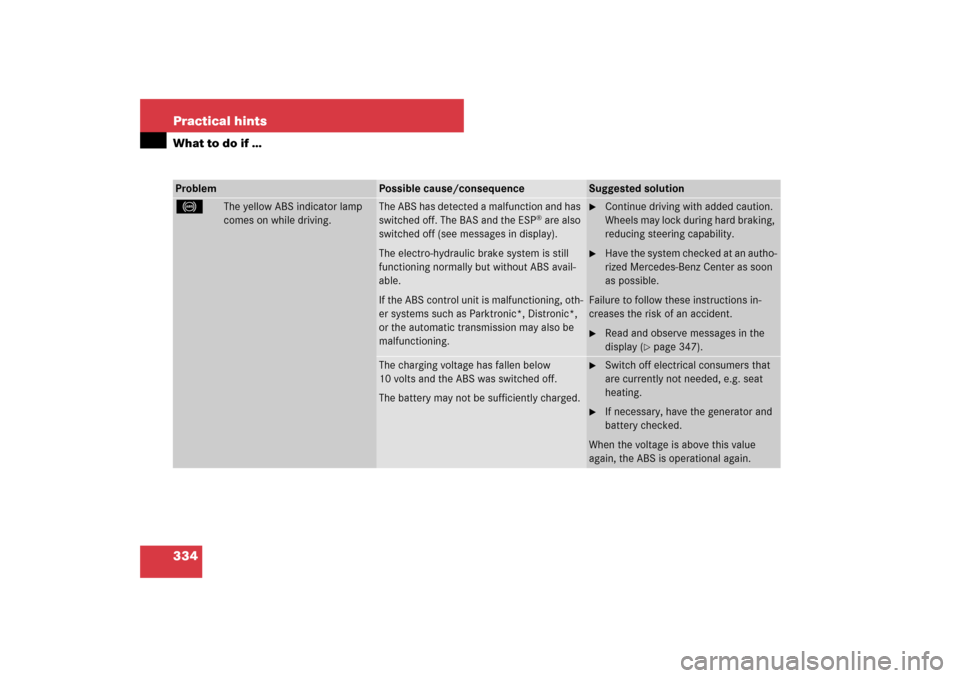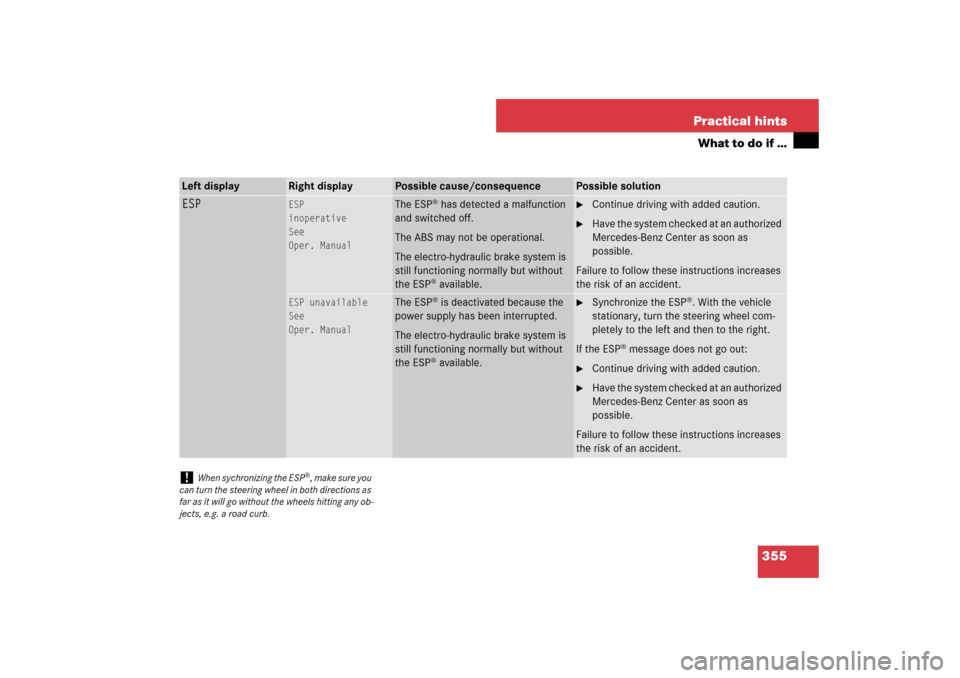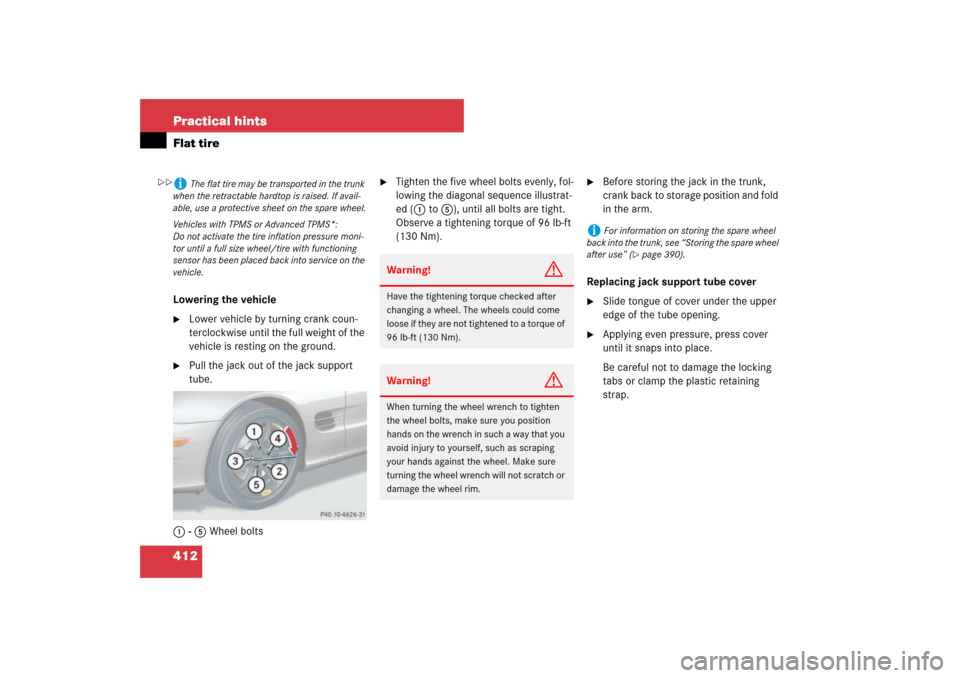Page 333 of 473

332 Practical hintsWhat to do if …Lamps in the instrument clusterGeneral information:
If any of the following lamps in the instru-
ment cluster fails to come on during thebulb self-check when switching on the igni-
tion, have the respective bulb checked and
replaced if necessary.Problem
Possible cause/consequence
Suggested solution
v
The yellow ABS/ESP
® warning
lamp comes on while driving.
The ESP
® has been switched off.
Risk of accident!
When the ESP
® is switched off it will not sta-
bilize the vehicle if the system recognizes
that the vehicle starts to skid or that a wheel
is spinning.
�
Switch the ESP
® back on (
�page 92).
Exceptions: (
�page 91).
�
If leaving the ESP
® switched off, adapt
your speed and driving to the prevail-
ing road and weather conditions.
If the ESP
® cannot be switched on:
�
Have the system checked at an autho-
rized Mercedes-Benz Center as soon
as possible.
The ESP
® is not operational due to a malfunc-
tion.
Risk of accident!
�
Observe additional messages in the
multifunction display.
�
Continue driving with added caution.
�
Adapt your speed and driving to the
prevailing road and weather condi-
tions.
�
Have the system checked at an autho-
rized Mercedes-Benz Center as soon
as possible.
Page 334 of 473
333 Practical hints
What to do if …
Problem
Possible cause/consequence
Suggested solution
v
The yellow ABS/ESP
® warning
lamp flashes while driving.
The ESP
®, ABS, or traction control has come
into operation because of detected traction
loss in at least one tire.
The cruise control and the Distronic* system
are deactivated.
�
When driving off, apply as little throt-
tle as possible.
�
While driving, ease up on the acceler-
ator.
�
Adapt your speed and driving to the
prevailing road and weather condi-
tions.
�
Do not deactivate the ESP
®.
Exceptions: (
�page 91).
Failure to follow these instructions in-
creases the risk of an accident.
Page 335 of 473

334 Practical hintsWhat to do if …Problem
Possible cause/consequence
Suggested solution
-
The yellow ABS indicator lamp
comes on while driving.
The ABS has detected a malfunction and has
switched off. The BAS and the ESP
® are also
switched off (see messages in display).
The electro-hydraulic brake system is still
functioning normally but without ABS avail-
able.
If the ABS control unit is malfunctioning, oth-
er systems such as Parktronic*, Distronic*,
or the automatic transmission may also be
malfunctioning.
�
Continue driving with added caution.
Wheels may lock during hard braking,
reducing steering capability.
�
Have the system checked at an autho-
rized Mercedes-Benz Center as soon
as possible.
Failure to follow these instructions in-
creases the risk of an accident.
�
Read and observe messages in the
display (
�page 347).
The charging voltage has fallen below
10 volts and the ABS was switched off.
The battery may not be sufficiently charged.
�
Switch off electrical consumers that
are currently not needed, e.g. seat
heating.
�
If necessary, have the generator and
battery checked.
When the voltage is above this value
again, the ABS is operational again.
Page 352 of 473
351 Practical hints
What to do if …
Left display
Right display
Possible cause/consequence
Possible solution
ABS
ABS, ESP
unavailable
See
Oper. Manual
The ABS and ESP
® are not available
due to a malfunction. The BAS is also
deactivated.
The system’s self-diagnosis may not
be completed yet.
The electro-hydraulic brake system is
still functioning normally but without
the ABS, the ESP®, and the BAS avail-
able.
�
Drive a short distance with added caution
at a vehicle speed of above 12 mph
(20 km/h).
When the message disappears, the ABS,
the ESP
®, and the BAS are available again.
If the message does not disappear:
�
Continue driving with added caution.
Wheels may lock during hard braking,
reducing steering capability.
�
Have the system checked at an authorized
Mercedes-Benz Center as soon as
possible.
Failure to follow these instructions increases
the risk of an accident.
Page 353 of 473

352 Practical hintsWhat to do if …Left display
Right display
Possible cause/consequence
Possible solution
ABS
ABS, ESP
inoperative
See
Oper. Manual
The ABS and ESP
® have switched off
due to a malfunction.
The BAS is also deactivated.
The electro-hydraulic brake system is
still functioning normally but without
the ABS, the ESP®, and the BAS avail-
able.
�
Continue driving with added caution.
Wheels may lock during hard braking,
reducing steering capability.
�
Have the system checked at an authorized
Mercedes-Benz Center as soon as
possible.
Failure to follow these instructions increases
the risk of an accident.
––– mph
Cruise control
You have attempted to set a speed be-
low 20 mph (30 km/h).
�
Accelerate to a speed exceeding
20 mph (30 km/h) and set the speed
(�page 210).
The ESP
® is switched off.
�
Switch on the ESP
® (�page 92).
The gear selector lever is set to posi-
tion P, R, or N.
�
Move the gear selector lever or position D.
The vehicle is secured with the parking
brake.
�
Release the parking brake (
�page 54).
Page 356 of 473

355 Practical hints
What to do if …
Left display
Right display
Possible cause/consequence
Possible solution
ESP
ESP
inoperative
See
Oper. Manual
The ESP
® has detected a malfunction
and switched off.
The ABS may not be operational.
The electro-hydraulic brake system is
still functioning normally but without
the ESP® available.
�
Continue driving with added caution.
�
Have the system checked at an authorized
Mercedes-Benz Center as soon as
possible.
Failure to follow these instructions increases
the risk of an accident.
ESP unavailable
See
Oper. Manual
The ESP
® is deactivated because the
power supply has been interrupted.
The electro-hydraulic brake system is
still functioning normally but without
the ESP® available.
�
Synchronize the ESP
®. With the vehicle
stationary, turn the steering wheel com-
pletely to the left and then to the right.
If the ESP
® message does not go out:
�
Continue driving with added caution.
�
Have the system checked at an authorized
Mercedes-Benz Center as soon as
possible.
Failure to follow these instructions increases
the risk of an accident.
!
When sychronizing the ESP
®, make sure you
can turn the steering wheel in both directions as
far as it will go without the wheels hitting any ob-
jects, e.g. a road curb.
Page 409 of 473
408 Practical hintsFlat tire1Jack support tube cover (except
SL 55 AMG, SL 65 AMG and vehicles
with Sport Package*)�
Open cover1 by pressing at point in-
dicated by arrow.
�
Remove cover1, taking care not to
damage the locking tabs.2Jack support tube cover (SL 55 AMG,
SL 65 AMG and vehicles with
Sport Package* only)
�
Insert a flat blade screwdriver in the
opening of cover2 and pry it out.
�
Remove cover2, taking care not to
damage the locking tabs.1Jack arm
2Jack support tube hole
3Crank
�
Insert jack arm1 fully into tube
hole2 up to the stop.Warning!
G
Insert the jack arm fully into the jack sup-
port tube hole up to the stop. Otherwise the
vehicle may fall from the jack and cause per-
sonal injury or damage to the vehicle.
��
Page 413 of 473

412 Practical hintsFlat tireLowering the vehicle�
Lower vehicle by turning crank coun-
terclockwise until the full weight of the
vehicle is resting on the ground.
�
Pull the jack out of the jack support
tube.
1 - 5 Wheel bolts
�
Tighten the five wheel bolts evenly, fol-
lowing the diagonal sequence illustrat-
ed (1 to 5), until all bolts are tight.
Observe a tightening torque of 96 lb-ft
(130 Nm).
�
Before storing the jack in the trunk,
crank back to storage position and fold
in the arm.
Replacing jack support tube cover
�
Slide tongue of cover under the upper
edge of the tube opening.
�
Applying even pressure, press cover
until it snaps into place.
Be careful not to damage the locking
tabs or clamp the plastic retaining
strap.
i
The flat tire may be transported in the trunk
when the retractable hardtop is raised. If avail-
able, use a protective sheet on the spare wheel.
Vehicles with TPMS or Advanced TPMS*:
Do not activate the tire inflation pressure moni-
tor until a full size wheel/tire with functioning
sensor has been placed back into service on the
vehicle.
Warning!
G
Have the tightening torque checked after
changing a wheel. The wheels could come
loose if they are not tightened to a torque of
96 lb-ft (130 Nm).Warning!
G
When turning the wheel wrench to tighten
the wheel bolts, make sure you position
hands on the wrench in such a way that you
avoid injury to yourself, such as scraping
your hands against the wheel. Make sure
turning the wheel wrench will not scratch or
damage the wheel rim.
i
For information on storing the spare wheel
back into the trunk, see “Storing the spare wheel
after use” (
�page 390).
��